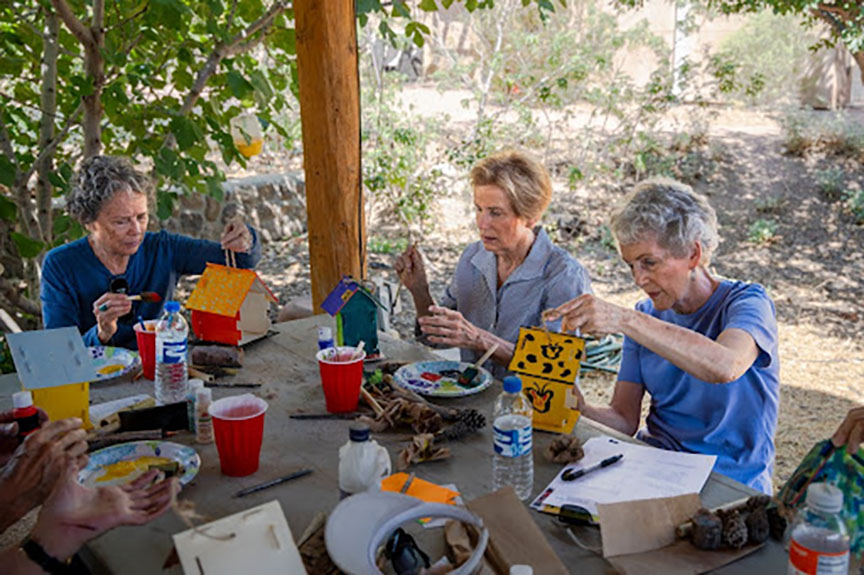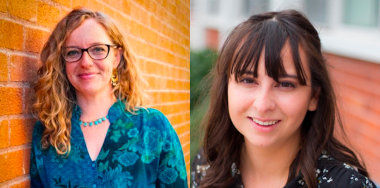Creative Encounters in Awe Walking: A journey into healthy aging through the arts
Jennie Gubner, PhD, assistant professor of music at the University of Arizona and ethnomusicologist by training, first learned about the concept of “awe walking” through her mentor Virginia Sturm.
It’s a wellness practice where participants take walks for typically 15 minutes or more, focusing on things that amaze and inspire them. Sturm, a University of California, San Francisco Associate Professor with a PhD in clinical psychology, demonstrated through her research that awe walking boosts positive emotions and well-being in participants.
Gubner, chair of the Applied Intercultural Arts Research Graduate Interdisciplinary Program, was inspired by Sturm’s findings and saw an opportunity for arts-based research to play a role in awe walking.
Portrait of Jennie Gubner (left) and Sydney Streightiff (right).
The research was perfect for building collaborations with the arts. “It just begs for the arts to be involved in this,” Gubner said. “I wanted to find ways to use art and creativity to help people tap into awe and to build awe finding toolkits.”
The ethnomusicologist focused on this practice in a three-month international arts research partnership called Encounters. Gubner asked Sydney Streightiff, her doctoral student, to be a part of the research.
“I asked [Streightiff] if she would like to help me brainstorm and build a project where we would ask, ‘What can creativity and the arts bring to awe walking as a wellness practice?’” Gubner said.
Experimenting with awe
In the beginning of their research, Gubner and Streightiff organized online discussion groups and asked people to look for themes, like shadows or specific colors, in their weekly walks. The idea was to use broad themes to help people tune into their everyday surroundings. For some, looking for awe can sound intimidating, but looking for textures or patterns or tiny things can make a walk feel like a treasure hunt that leads to awe. Streightiff had the idea to layer art over awe walking. Following their walks, the group would explore theme-related art practices and share their findings with one another.
After being invited to present on this project at the UArizona Wonder House at South by Southwest, the team also worked with the Center for Digital Humanities at the University of Arizona to create a website called The Awe Collective. Participants anywhere in the world can upload awe-inspiring images and place them on a map to help inspire others to go on awe walks.
They received funding from Innovations in Healthy Aging around this time and developed in-person workshops for the Tucson community and beyond. Like the initial explorations, they decided to combine the practice of different art forms and awe walking in a program called the Aging and the Arts Creative Encounters in Awe Walking Workshop. The events typically collaborate with a local Tucson organization and involve a brief discussion of awe, a walk to reflect on the theme and a creative workshop open to all artistic skill levels.
One of their first events was centered around photography and light at the Center for Creative Photography. The researchers introduced the concept of awe walking and then the teaching artist Meg Jackson Fox gave a lecture about how photographers in the Southwest have used light in creative ways in their photos. The group then took a walk around campus putting into practice what they had learned.
Though this new program did not have the lively online group chats of their initial research, Gubner and Streightiff found a common theme between the first two events.
“We quickly figured out that one of the things people really enjoyed was just being together,” Gubner said. “We also realized that even if participants did no other awe walking outside of our workshops, there was value in offering people a space to connect with awe and creativity in a social setting for two hours a month.”
It was a change from their previous work, focusing less on what participants can do outside of the workshop but rather cultivating the two hours they had together.
Sturm had taught Gubner that the more awe people feel, the easier it is to tap into this emotion. As people returned month after month, it became clear that the creative workshops were offering valuable opportunities for participants to explore awe in a community setting.
“There was a shift of ‘Can we give people homework?’ to ‘We're just excited to have you here and to introduce you to different people in different spaces in our town,” Gubner said.
The project, initially slated for three months, quickly turned into more than a year-long endeavor.
“It was going to be a standalone event but then turned into a workshop series,” Streightiff said.
The process, not the product
Through the events, they found people love being “playfully engaged in artistic practices” as they are given the space to paint, create collages or even watch birds as part of the workshops.
“The act of playing artistically can be a really positive experience that shifts focus away from the preoccupations with being a ‘good’ artist,” Gubner said.
Gubner emphasized it was about the process rather than the product.
“You're not here to show us how well you can draw,” Gubner said. “Instead, we’re going to give you a bunch of colors and we want you to just play with color and enjoy the experience, enjoy tapping into that sense of playful, childlike wonder that children bring to the arts.”
Changes and growth
An unexpected outcome of the Creative Encounters in Awe Walking program has been the ability to cultivate relationships with community organizations outside of the UArizona.
“This series wasn't intended to be ‘what are all the most awe-inspiring places in Tucson?’ but it has kind of become that,” Gubner said.
There’s also been a shift in how they approach themes.
“In the beginning, we were trying to focus on all the original themes we had come up with related to building an awe toolkit… Now [it’s] much more about the people and the places we want to partner with, understanding that other awe-inspiring themes will emerge organically from those collaborations,” Gubner said.
The awe walking program has seen a regular group form throughout their events.
“It’s exciting because we have a flow of new people coming and a core group of people who come to every event,” Streightiff said.
An uncertain but hopeful future for the program
Creative Encounters in Awe Walking has been funded through the University of Arizona's strategic initiative Innovations in Healthy Aging, which is ending. Still, Gubner is hopeful about the future.
“I think we just have to think creatively about how to find partners that might bring new sources for funding or reimagine what kinds of sustainable collaborations we can build moving forward… We are eager to find ways to scale and spread this work and are actively looking to talk to anyone interested in working with us,” Gubner said.
More about the program
To read more about Innovations in Healthy Aging’s dedication to promoting healthy living habits in aging adults, read the UArizona’s Health Sciences annual report.
To learn more about awe walking, Gubner and Streightiff encourage readers to try going on a short awe walk, and then to explore and contribute to their website, The Awe Collective, visit their website here. To view upcoming awe walking events, visit Innovations in Healthy Aging’s Aging and the Arts page. For more perspectives on awe, read this story about Susan, a regular participant in our events.




